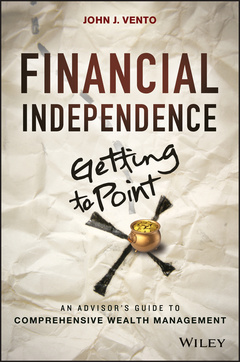Description
Financial Independence (Getting to Point X)
Author: Vento John J.
Language: English
Approximative price 38.02 €
In Print (Delivery period: 12 days).
Add to cart
Publication date: 04-2013
Description
/li>Contents
/li>
Discover the ten key issues to achieving your financial goals and how to use them to realize your dream of financial independence From saving to purchase a first car, to putting kids through college to planning for retirement, to preserving your estate for your loved ones, our financial goals change from one stage of life to the next. While those goals and the challenges we face in achieving them may differ, all of them have certain things in common. Saving, budgeting, managing debt, minimizing taxes and living within your means. These are a few of the 10 Key Wealth Management Issues which come into play (to varying degrees) when working toward specific financial goals. But there′s one goal for which success relies on all ten keys coming together in perfect harmony: financial independence, also known as "Point X." No matter how you define it—whether it′s a retirement income of $25,000 a year, or an estate worth $250 million—your future financial independence requires that you deal effectively with all ten key issues. And now this book shows you how to get it done, along with the guidance of a trusted advisor. Supplies you with a complete roadmap for arriving at "Point X," financial independence with key milestones and important twists and turns clearly defined Identifies the 10 key wealth management issues and offers priceless advice and guidance on negotiating each on your road to financial independence Provides you with both success and failure stories so you can learn from others′ real life experiences Provides you with tax planning facts and strategies within the wealth management issues that will show you how to minimize your most significant expense and at the same time maximize your savings on the road to your "Point X"
Preface: Living the American Dream xiii Acknowledgments xvii Introduction Getting to Point X xix Financial Literacy and the New Norm xx Point X: Our Fundamental Financial Goal xxi Ten Key Issues to Comprehensive Wealth Management xxii Our Biggest Expense xxiii Take a Financial Planning Checkup xxiv The Power of This Book xxvii Chapter 1 Committing to Living within Your Means 1 The American Dream Becomes the American Nightmare 1 Living within Your Means: The Essential Step 2 Simple Saving 6 Chapter 2 Understanding Taxes 11 A Brief History of the U.S. Tax System 12 Organizing and Retaining Your Records 15 Tax–Preparation Services 16 Accumulating Wealth through Tax Planning 18 Chapter 3 Determining Your Financial Position 23 Figuring Your Financial Net Worth 24 Case Study: How One Couple Learned They Were Spending More Than They Earned 24 Making Sense of Cash Flow 35 Establishing Your Financial Goals 57 Finding Trusted Advisors 61 Chapter 4 Managing Debt 67 Case Study: How Two Doctors Went Bankrupt in Only a Few Years—What Not to Do 67 Basic Principles for Managing Debt 71 Good Debt versus Bad Debt 73 Credit–Card Debt 74 Auto Loans 80 Student Loans 81 Home Mortgage Loans 82 Business and Investment Loans 86 Understanding Credit 87 Your Credit Report and Your Credit Score 89 Preventing Identity Theft 93 Analyzing Your Debt 94 Chapter 5 Insuring Your Health and Life 99 Choosing a Health Insurance Plan 100 Long–Term Care Insurance 111 Disability Insurance 118 Life Insurance 122 Buying Insurance Policies 128 Chapter 6 Protecting Your Property with Insurance 133 Case Study: How a Lack of Insurance Wiped Out One Woman’s Life Savings 134 Homeowner’s Insurance 136 Automobile Insurance 140 Umbrella Liability Insurance 144 Buying Insurance Policies 147 Chapter 7 Paying for College 153 Case Study: How Not Saving for Your Child’s Education Can Ruin Your Finances—and Your Child’s 156 Conducting a “Needs Analysis” for Your Children’s College Educations 160 Strategies for Saving Money for College Education 162 Education Tax Deductions and Credits 179 Chapter 8 Planning for Retirement 187 Case Study: Saving versus Not Saving for Retirement: The $1.7 Million Difference 187 Retirement Equation: Calculating Your Personal Point X 191 The High Cost of Waiting to Save for Retirement 193 What You Can Expect to Receive from Social Security 196 Qualified Retirement Plans 198 The Difference between Traditional IRAs and Roth IRAs 203 Fixed and Variable Annuities 209 Retirement Funding: “Needs Analysis” 212 Chapter 9 Managing Your Investments 221 Analyzing Your Risk Tolerance 222 Stocks, Bonds, Mutual Funds, and Exchange–Traded Funds 226 Diversification and Modern Portfolio Theory 234 Asset Allocation and Rebalancing 237 Dollar–Cost Averaging 243 Inflation and Taxes: The Biggest Drains on Investment Return 245 Medicare Surtax on Net Investment Income 246 Chapter 10 Preserving Your Estate 251 The Federal Gift and Estate Tax System 252 Legal Documents to Consider for Estate Planning 252 The Probate and Administration Process and Why You May Want to Avoid It 257 Using a Planned Gifting Strategy 261 Ownership of Property and How It Is Transferred 262 Reasons for Creating a Trust 265 Benefit from a Family Limited Partnership 277 Estate Tax Planning and Life Insurance 278 Chapter 11 The Time Value of Money 285 The Rule of 72 286 Appendix A: Selecting a Trusted Advisor 301 Appendix B: 101 Ways to Save $20 or More per Week 311 Appendix C: Basic Concepts and Definitions of Various Types of Taxes 321 About the Author 341 Index 343
© 2024 LAVOISIER S.A.S.




